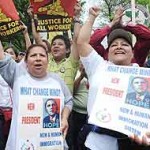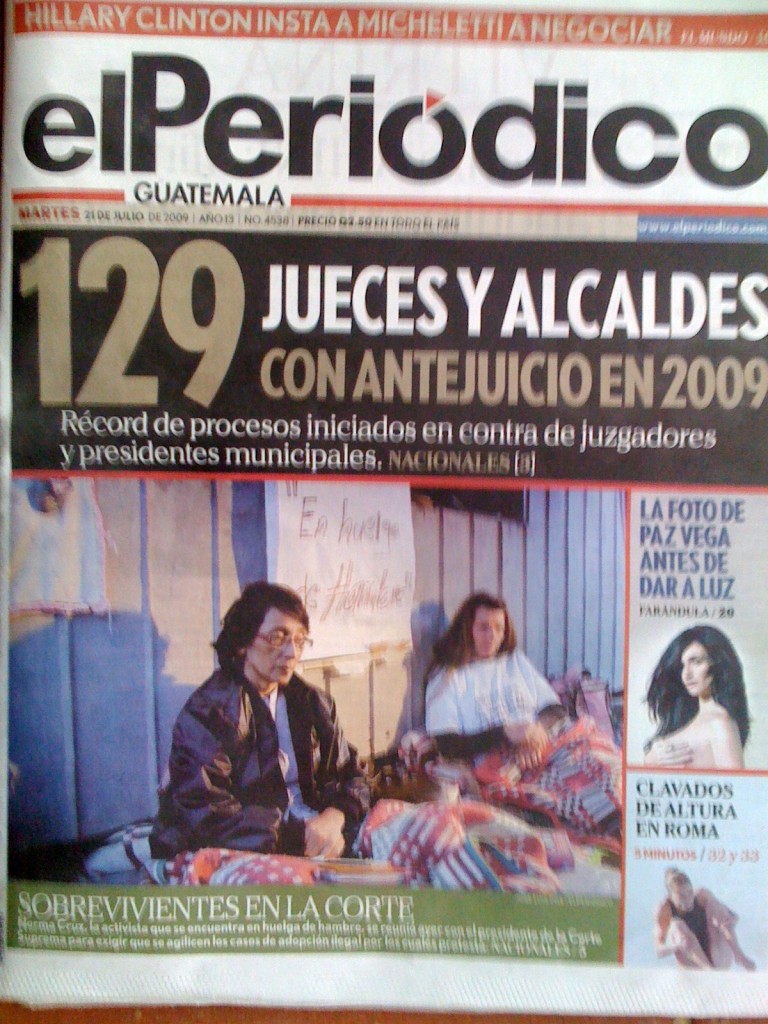By JULIA PRESTON
In an unusually protracted and closely watched case, the Obama administration has recommended political asylum for a Guatemalan woman fleeing horrific abuse by her husband, the strongest signal yet that the administration is open to a variety of asylum claims from foreign women facing domestic abuse.

Jim Wilson/The New York Times. Rody Alvarado is shown at a lawyer's offices in San Francisco. The Obama Administration has recommended a granting her asylum.
The government’s assent, lawyers said, virtually ensures that the woman, Rody Alvarado Peña, will be allowed to remain in the United States after battling in immigration court since 1995.
Immigration lawyers said the administration had taken a major step toward clarifying a murky area of asylum law and defining the legal grounds on which battered and sexually abused women in foreign countries could seek protection here.
After 14 years of legal indecision, during which several immigration courts and three attorneys general considered Ms. Alvarado’s case, the Department of Homeland Security cleared the way for her in a one-paragraph document filed late Wednesday in immigration court in San Francisco. Ms. Alvarado, the department found, “is eligible for asylum and merits a grant of asylum as a matter of discretion.”
An immigration judge’s order granting the asylum is still required, but Ms. Alvarado’s lawyer, Karen Musalo, said that since the government had raised no new opposition, it was highly likely that the judge would approve her claim.
Ms. Musalo, director of the Center for Gender and Refugee Studies at Hastings College of the Law at the University of California, said Ms. Alvarado’s “has been the iconic case of domestic abuse as a basis for asylum.”
Jayne Fleming, a lawyer specializing in asylum at the San Francisco office of the law firm Reed Smith, called the recommendation “a giant step forward.” Advocates and immigration judges, Ms Fleming said, “now have some pretty solid guidelines from D.H.S.”
In a phone interview Thursday, Ms. Alvarado, who has not been detained and lives in California, where she is a housekeeper at a home for elderly nuns, said she was pleased but also a little dazed and disbelieving.
“I thank God it came out well,” she said, speaking in Spanish. “But it wasn’t easy to wait this long for immigration to make a decision.”
She said she hoped the outcome in her case would mean that other abused women would receive quicker decisions from the courts.
Homeland Security Department officials were cautious in assessing the implications of the administration’s recommendation. The department “continues to view domestic violence as a possible basis for asylum,” a department spokesman, Matthew Chandler, said. But such cases, Mr. Chandler said, continue to depend on the specific abuse. The department is writing regulations to govern claims based on domestic violence, he said.
After enduring a decade of violence by her husband, Francisco Osorio, a former soldier in Guatemala, Ms. Alvarado came to the United States in 1995. Over the years, immigration judges have not questioned the credibility of her story. According to court documents, she married when she was 16, and became pregnant soon afterward. In a beating that he apparently hoped would induce an abortion, Mr. Osorio dislocated her jaw and kicked her repeatedly. He also “pistol-whipped Ms. Alvarado, broke windows and mirrors with her head, punched and slapped her, threatened her with his machete and dragged her down the street by her hair,” a court filing states.
In 1996, an immigration judge in San Francisco granted Ms. Alvarado’s asylum petition, but an immigration appeals court overturned that decision in 1999. In 2001, Attorney General Janet Reno threw out the appeals court decision, but did not grant Ms. Alvarado asylum. (Because the immigration courts are part of the executive branch, not the judiciary, the attorney general is the highest legal authority.)
In 2004, the Department of Homeland Security, which represents the government in immigration cases, argued for the first time in favor of asylum for Ms. Alvarado. Attorney General John Ashcroft ordered a new review but did not reach a decision. In September 2008, Attorney General Michael B. Mukasey sent the case back to the immigration appeals court, encouraging the court to issue a precedent-setting ruling. Such a ruling can come only from an immigration appeals court or a federal court.
The large legal question in the case is whether women who suffer domestic abuse are part of a “particular social group” that has faced persecution, one criteria for asylum claims. In a separate asylum case in April, the Department of Homeland Security pointed to some specific ways that battered women could meet this standard.
In a recent filing, Ms. Alvarado’s lawyers argued that her circumstances met the requirements that the department had outlined in April. Now the department has agreed, in practice making the case a model for other asylum claims.
In a declaration filed recently to bolster Ms. Alvarado’s argument that she was part of a persecuted group in Guatemala, an expert witness, Claudia Paz y Paz Bailey, reported that more than 4,000 women had been killed in domestic violence there in the last decade. These killings, only 2 percent of which have been solved, were so frequent that they earned their own legal term, “femicide,” said Ms. Paz y Paz Bailey, a Guatemalan lawyer. In 2004 Guatemala enacted a law establishing special sanctions for the crime.
“Many times,” she said, violence against Guatemalan women “is not even identified as violence, is not perceived as strange or unusual.”
The resolution of her case is coming too late for Ms. Alvarado to be able to raise her two children, whom she has not seen since she left them in Guatemala. The children, now 22 and 17, were raised by their paternal grandparents, whom they call Mama and Papa.
“It has been tremendously painful for me to know that they do not see me as their mother,” Ms. Alvarado said in court papers.












 Proud Founder Member of the Guatemala Peace and Development Network
Proud Founder Member of the Guatemala Peace and Development Network